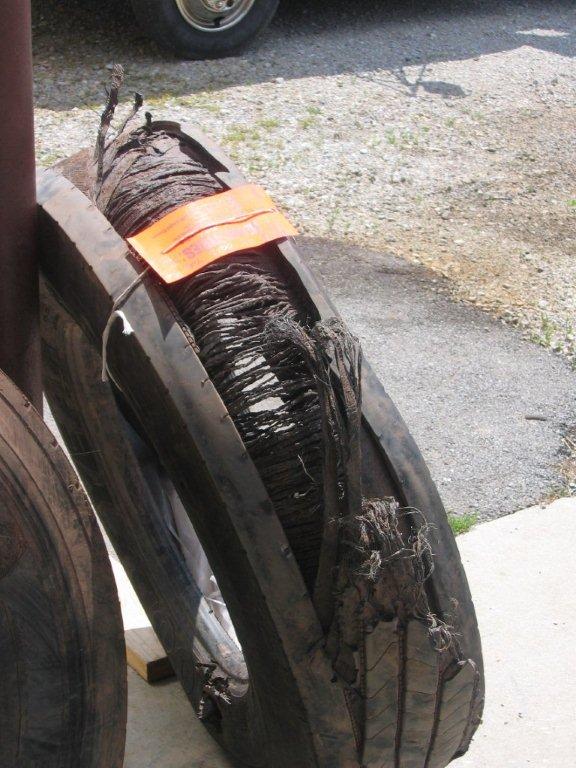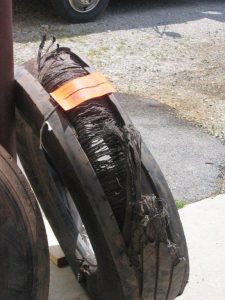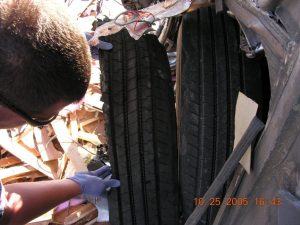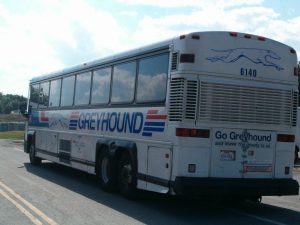
By Larry Yohe
During the summer months operators tend to focus attention on the A/C and cooling systems, and often overlook tire failure as a concern that deserves equal consideration—particularly on the steer axle. One large carrier that has kept records of tire incidents over the past 10 years allowed me to review its records, which revealed that summer tire failures have occurred three times more often than in winter.
Some of this information may apply to vehicles at large but it specifically addresses front tire failures on a 45-foot motorcoach, which has become the industry standard.
My interest in this topic peaked in summer of 2006 when I investigated a bus accident that occurred in a rural area of NY. A 45-foot motorcoach descending a 5-percent grade on an interstate highway suddenly veered to the left, went through a cable guardrail, traveled briefly along a hillside and then rolled over and came to rest on its roof. This accident resulted in five fatalities and 48 injuries.
During the past five years in the United States, front tire failures on 45-foot motorcoaches have accounted for no less than 24 deaths and over 200 injuries. A front tire failure can unquestionably turn into a catastrophic event.
Prior to my arrival on the scene, officers had discovered the left front tire was flat with much of its tread missing. The evidence on the roadway, corroborated by a forensic tire examination, revealed the tire had delaminated; the tire tread had come off the body of the tire due to heat buildup, ultimately resulting in a blown tire.
Similar incidents have occurred in PA, NV, AL and TX with the most notable coach crash occurring in 2008 near Sherman, TX, that resulted in the deaths of 17 passengers.
In the case of the NY accident, I left the scene with plenty of questions but few answers for how the tire failure occurred. If the tire was low on air, why couldn’t the driver feel it pulling at the steering wheel? Did braking cause the vehicle to veer so sharply to the left? Was the power steering unit large enough to produce the needed pressure? Did the driver have both hands on the wheel or were the forces simply too powerful to overcome? What type of noise did the driver hear? Was the tire defective? How quickly did this event take place?
Flat tires happen every day but in my 30-plus years as an accident investigator, both with the state police and the National Transportation Safety Board (NTSB), I have never heard of a bus accident resulting from a flat tire, especially one that resulted in this type of trauma. An alert driver should be able to control a flat tire, or so I believed.
Putting the issue to the test
In the months following this accident, I attempted to locate a test track to do dynamic testing. I wanted to learn what the driver might feel at the steering wheel prior to and during a delamination or blowout.
A non-involved company, Continental Tire, graciously provided an 8.5-mile test track and Greyhound Bus Lines provided a bus and a maintenance crew. We outfitted the vehicle with three cameras outside the left front wheel well and a GPS system to monitor time and speed, as well as SmarTire, which one of its technicians monitored. TRW provided a test engineer who installed and monitored a load cell steering wheel that would record the forces the driver felt at the steering wheel. Stewart and Stevenson-Dallas provided a technician to monitor data from the engine. ECM and the NTSB supplied a human performance expert to record data. I acted as the test driver.
Due to the potential risks, we installed special seat belts for the participants riding in the bus. Other government and industry participants included representatives from the Federal Motor Carrier Safety Administration (FMCSA).
Over the course of five days we intentionally dynamically failed 15 left front tires, seven by blowouts and eight by delamination.
The first two attempted blowouts occurred when a controller inside the bus remotely fired a mounted shotgun with the coach traveling between 50 and 60 mph. In these two tests, it took several seconds for the tire to deplete. This presented no problems for this driver as very light forces were present at the steering wheel, which I easily controlled with one hand.
An explosive charge replaced the shotgun for the remaining five blowout tests, conducted between about 61 and 75 mph. They produced a variety of results at the steering wheel, with the fourth blowout test resulting in momentary steering forces as high as 300-inch lbs. (25-foot lbs.)—the highest experienced during the eighth blowout test. Though it took two forceful hands on the steering wheel, there was never a sense the bus was going to go out of control.
With the test bus loaded with sand bags to simulate a fully occupied vehicle with passengers and luggage, the gross vehicle weight was 52,480 lbs., with a front axle weight of 16,280 lbs.. When we lowered the pressure in the left front tire to 60 psi, test participants were surprised to see the left tire did not appear low on air. The difference between the appearance of the left front tire and the fully-inflated right front tire was barely discernible.
In all eight delamination tests while driving around the track with left front tire air pressures as low as 24.3 psi, I never felt any pull on the steering wheel, a fact the TRW test engineer recognized.
Another important factor worth mentioning: a vibration or slight rumble usually felt in the steering wheel accompanied all delaminations, which would last anywhere between a few seconds to at least 30 seconds before the tire failed.
We conducted all eight delaminations at highway speeds of 70 to 80 mph. The first test began with a tire fully inflated at 120 psi, while the remaining tests dropped to around 60 psi. After completing the 8.5-mile lap, the bus would stop to have the air pressure lowered about 10 psi and take off again at highway speeds. During each test run, the inner tire temperature increased each time we lowered the air pressure.
In seven of the eight tests, the delamination occurred with the inner tire temperature between 297 and 320 degree Fahrenheit. One occurred at 266 degrees. The average tire pressure at delamination was 37 psi, with a low of 24.3 psi and a high of 54.6 psi. Of the eight delaminations, most were easily controllable, with forces at the steering wheel up to about 150-inch lbs.. However in one test the forces were between 290- and 360-inch lbs., with a momentary spike over 700-inch lbs. These sustained forces presented the greatest challenge of all the tests. In short, I felt a struggle with the steering wheel, a fact the instrumented steering wheel and a video camera confirmed. I can only speculate had this occurred on the highway, the bus would likely have gone off the roadway.
This could be because a driver simply might not have the physical strength to overcome the force, but also because of the element of surprise when confronted with such unexpected force at the steering wheel. In the test I had the knowledge that a tire failure was about to occur and was prepared to grip the steering wheel forcefully.
The 15 tests revealed that not all tire failures are the same. Some required minimal steering force to control, some moderate and one was extremely difficult. While there are many variables here, the testing indicated the possibility of an uncontrollable event. In the NY accident, passengers said the driver struggled with the steering wheel. In two other cases where the NTSB conducted limited investigations, passengers stated the driver struggled with the steering wheel. In one of these cases a surviving driver furnished a written statement to the effect the driver tried her hardest to keep the coach on the roadway, a fact other passenger statements verified.
In another case involving a delamination, the surviving driver said the bus dove to the left. In this case a DDEC IV Last Stop Record was available, which showed bus speed dropping from 71 to 66 mph in one second without any braking. The bus then went off the roadway and rolled over, fortunately without any fatalities. The driver in the Sherman, TX, accident involving stated he was unable to control the steering wheel. While there is other information available to substantiate the difficulties in controlling a front tire failure, a prima facie case can be made to show that some front tire failures are either extremely difficult to control or are simply uncontrollable. BR
Larry Yohe worked with the NTSB for nearly 25 years, with the majority of his time spent on truck and bus issues. He is now a motorcoach consultant and still drives professionally. He can be contacted at zephyr5@flash.net.




